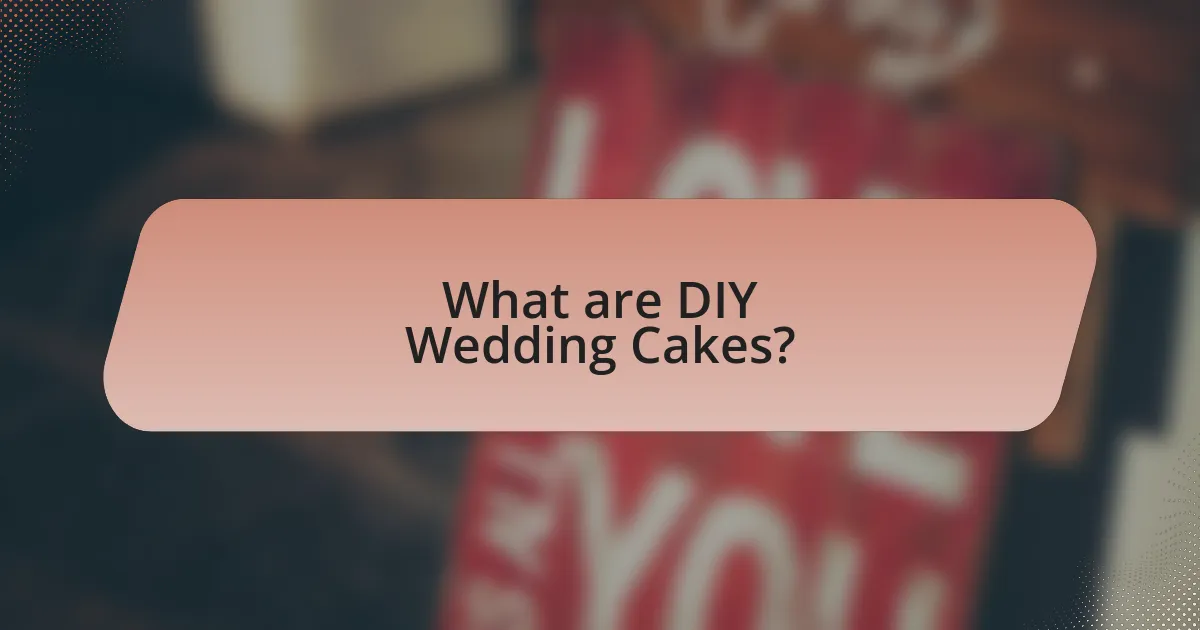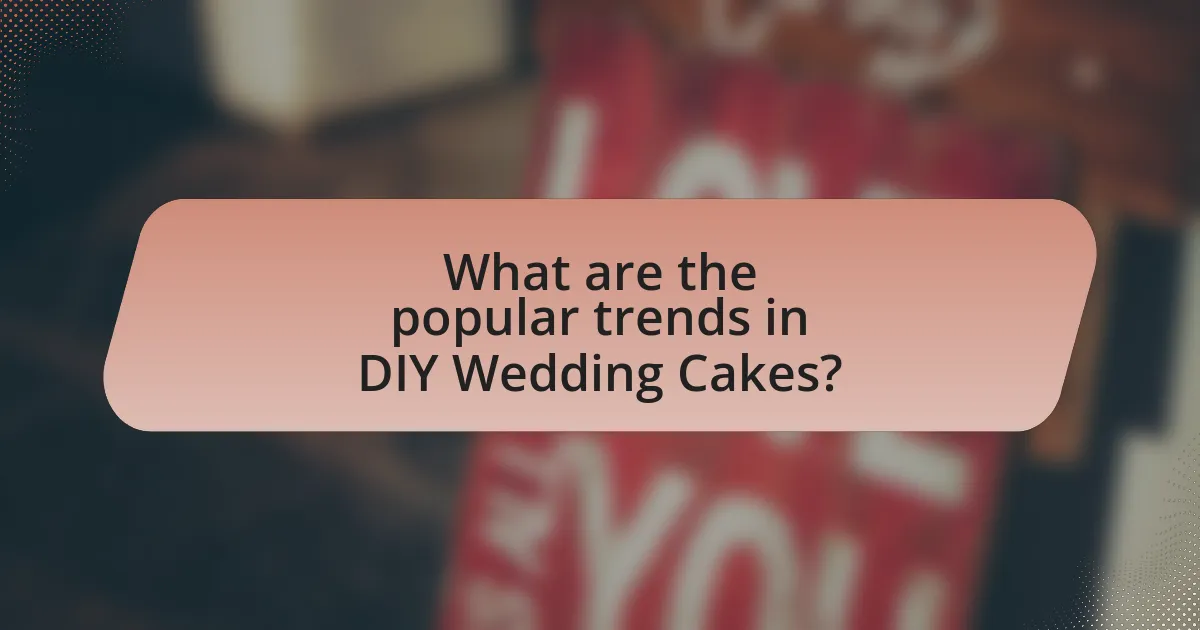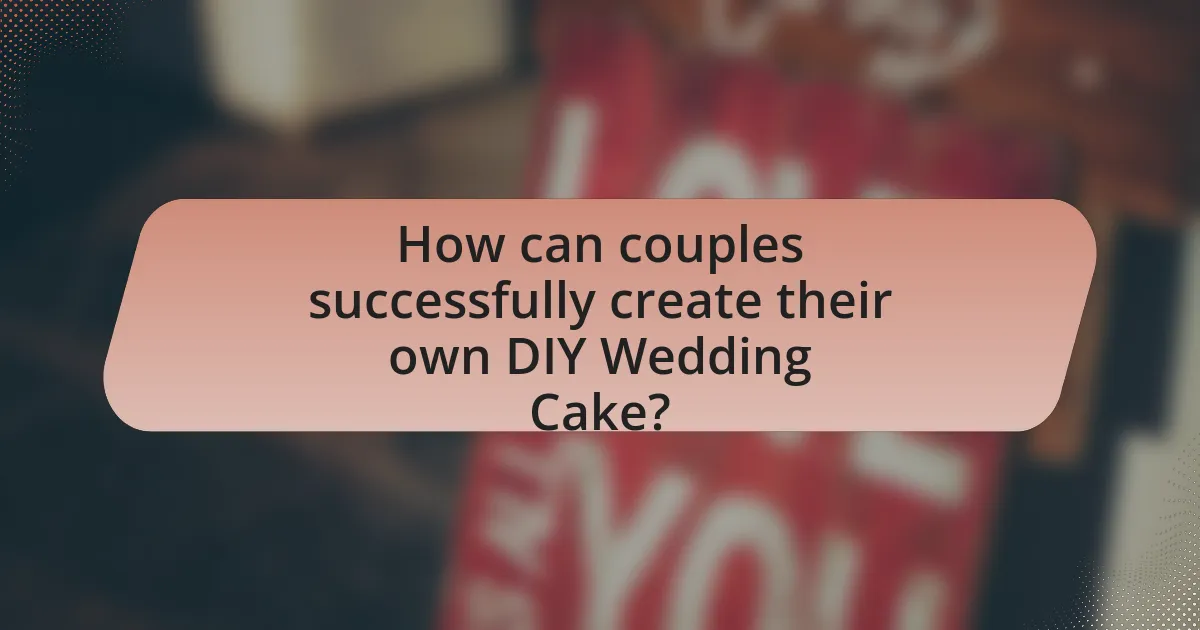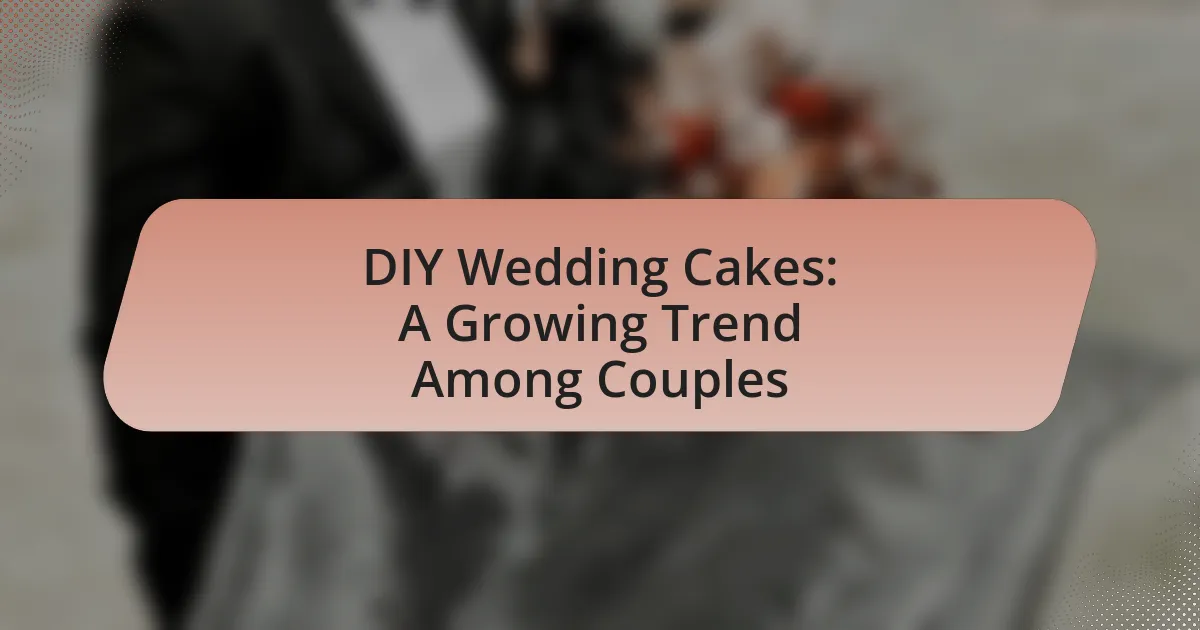DIY wedding cakes are an increasingly popular choice among couples, allowing for personalization and cost savings compared to traditional bakery options. This article explores the differences between DIY and professional wedding cakes, detailing the ingredients, tools, and techniques necessary for successful creation. It also addresses the motivations behind choosing DIY cakes, the challenges couples may face, and the impact of social media on cake design trends. Additionally, it provides practical tips for planning, baking, and decorating, ensuring couples can effectively manage their time and resources while crafting a meaningful centerpiece for their wedding celebration.

What are DIY Wedding Cakes?
DIY wedding cakes are cakes that couples create themselves for their wedding, rather than purchasing from a bakery. This trend allows couples to personalize their wedding experience, often reflecting their tastes and creativity. According to a survey by The Knot, approximately 30% of couples opt for DIY elements in their weddings, including cakes, to save costs and add a personal touch.
How do DIY Wedding Cakes differ from traditional wedding cakes?
DIY wedding cakes differ from traditional wedding cakes primarily in their preparation and customization. DIY wedding cakes are typically made by the couple or their friends and family, allowing for a more personal touch and unique designs that reflect the couple’s style. In contrast, traditional wedding cakes are usually crafted by professional bakers, ensuring a level of expertise and consistency in taste and presentation. Additionally, DIY cakes often utilize simpler recipes and ingredients, which can lead to cost savings, while traditional cakes may incorporate more elaborate techniques and premium ingredients, resulting in higher costs.
What ingredients are typically used in DIY Wedding Cakes?
DIY wedding cakes typically use flour, sugar, eggs, butter, and baking powder as their main ingredients. These components form the base of the cake, with flour providing structure, sugar adding sweetness, eggs contributing moisture and binding, butter enriching flavor, and baking powder acting as a leavening agent. Additionally, many recipes incorporate vanilla extract for flavor, milk for moisture, and various fillings or frostings such as cream cheese or buttercream to enhance taste and presentation. The combination of these ingredients allows for a variety of flavors and textures, making DIY wedding cakes customizable to suit individual preferences.
What tools and equipment are necessary for creating DIY Wedding Cakes?
To create DIY wedding cakes, essential tools and equipment include mixing bowls, measuring cups, a stand mixer or hand mixer, baking pans, a cooling rack, a cake leveler, offset spatulas, and a cake turntable. Mixing bowls are necessary for combining ingredients, while measuring cups ensure accurate ingredient quantities. A stand mixer or hand mixer facilitates thorough mixing of batter, and baking pans are required for shaping the cakes. A cooling rack allows cakes to cool evenly, and a cake leveler ensures uniform layers. Offset spatulas are used for frosting and smoothing, and a cake turntable aids in decorating the cake evenly. These tools are fundamental for achieving a professional-looking DIY wedding cake.
Why are couples choosing DIY Wedding Cakes?
Couples are choosing DIY wedding cakes primarily for cost savings and personalization. By making their own cakes, couples can significantly reduce expenses, as professional wedding cakes can range from hundreds to thousands of dollars. Additionally, DIY cakes allow couples to customize flavors, designs, and decorations to reflect their unique tastes and styles, enhancing the personal significance of the cake on their special day. This trend is supported by the increasing availability of online tutorials and baking supplies, making it easier for couples to successfully create their desired cake.
What are the cost benefits of making a DIY Wedding Cake?
Making a DIY wedding cake can significantly reduce costs compared to purchasing one from a bakery. The average bakery wedding cake can range from $300 to $1,000, while the ingredients for a homemade cake typically cost between $50 and $150, depending on the size and complexity. By opting for a DIY approach, couples can save up to 80% on cake expenses. Additionally, making the cake allows for customization, which can eliminate the need for expensive design fees often charged by professional bakers. This cost-effective strategy not only provides financial savings but also adds a personal touch to the wedding celebration.
How does making a DIY Wedding Cake enhance the personal touch of a wedding?
Making a DIY wedding cake enhances the personal touch of a wedding by allowing couples to incorporate their unique tastes, memories, and creativity into a central element of the celebration. This hands-on approach enables couples to select flavors, designs, and decorations that reflect their personalities and relationship history, making the cake a meaningful symbol of their union. Additionally, the process of creating the cake can involve family and friends, fostering a sense of community and shared experience that further personalizes the event. Studies show that personalized elements in weddings, such as custom cakes, can significantly increase guest satisfaction and emotional connection to the event, reinforcing the importance of personal touches in wedding planning.
What challenges do couples face when making DIY Wedding Cakes?
Couples face several challenges when making DIY wedding cakes, including time constraints, skill level, and ingredient sourcing. Time constraints can lead to rushed preparations, which may affect the cake’s quality and design. Many couples lack the necessary baking and decorating skills, resulting in cakes that may not meet their expectations. Additionally, sourcing high-quality ingredients can be difficult, especially if couples are trying to adhere to specific dietary restrictions or preferences. These challenges can ultimately impact the overall success of the DIY wedding cake project.
How can time management impact the success of a DIY Wedding Cake?
Effective time management significantly enhances the success of a DIY wedding cake by ensuring that all preparation, baking, and decorating tasks are completed efficiently and on schedule. Properly allocating time allows for thorough planning, which includes gathering ingredients, practicing techniques, and allowing adequate cooling and setting times for the cake layers and decorations. Research indicates that poor time management can lead to rushed decisions, resulting in mistakes such as underbaking or improper decoration, which can compromise the cake’s quality and appearance. Therefore, a structured timeline not only minimizes stress but also increases the likelihood of achieving a visually appealing and delicious cake that meets the couple’s expectations.
What common mistakes should be avoided when creating a DIY Wedding Cake?
Common mistakes to avoid when creating a DIY wedding cake include inadequate planning, improper ingredient measurements, and neglecting to account for temperature and humidity. Inadequate planning can lead to last-minute issues, such as insufficient time for baking or decorating. Improper ingredient measurements can result in a cake that does not rise correctly or has an undesirable texture. Additionally, neglecting temperature and humidity can affect the cake’s stability and frosting consistency, leading to a less appealing final product. These mistakes can significantly impact the overall quality and presentation of the wedding cake.

What are the popular trends in DIY Wedding Cakes?
Popular trends in DIY wedding cakes include the use of natural ingredients, minimalist designs, and unique flavor combinations. Many couples are opting for organic and locally sourced ingredients to create healthier and more sustainable cakes. Additionally, minimalist designs featuring simple, elegant decorations are gaining popularity, as they align with modern wedding aesthetics. Unique flavor combinations, such as lavender lemon or chocolate raspberry, are also trending, allowing couples to personalize their cakes beyond traditional vanilla or chocolate options. These trends reflect a shift towards personalization and sustainability in wedding planning.
How are flavors and designs evolving in DIY Wedding Cakes?
Flavors and designs in DIY wedding cakes are evolving towards more personalized and unique options that reflect individual tastes and themes. Couples are increasingly opting for unconventional flavors such as lavender, matcha, and salted caramel, moving away from traditional vanilla and chocolate. Additionally, designs are becoming more artistic, with trends like watercolor effects, geometric shapes, and floral embellishments gaining popularity. This shift is supported by the rise of social media platforms, where couples share their creative cake designs, inspiring others to experiment with flavors and aesthetics that resonate with their personal stories and wedding themes.
What unique flavor combinations are trending for DIY Wedding Cakes?
Unique flavor combinations trending for DIY wedding cakes include lavender and lemon, chocolate and raspberry, and vanilla bean with chai spice. These pairings are gaining popularity due to their ability to offer a sophisticated yet approachable taste experience. For instance, lavender and lemon provide a refreshing floral note balanced by citrus brightness, while chocolate and raspberry create a rich, indulgent contrast. Vanilla bean with chai spice introduces warmth and complexity, appealing to couples seeking unique flavors that reflect their personal tastes.
How do design trends influence the aesthetics of DIY Wedding Cakes?
Design trends significantly influence the aesthetics of DIY wedding cakes by dictating popular styles, colors, and decoration techniques. For instance, the rise of minimalist design has led many couples to opt for simple, elegant cakes featuring clean lines and subtle color palettes, reflecting a broader trend in wedding aesthetics towards understated sophistication. Additionally, the popularity of natural and organic themes has encouraged the use of fresh flowers and greenery, aligning with the trend of incorporating nature into wedding decor. According to a survey by The Knot, 30% of couples in 2022 chose cakes that featured floral designs, showcasing how current design trends directly shape cake choices.
What role do social media and online resources play in DIY Wedding Cakes?
Social media and online resources significantly enhance the DIY wedding cake process by providing inspiration, tutorials, and community support. Platforms like Pinterest and Instagram showcase countless cake designs, enabling couples to visualize their ideas and select styles that resonate with their preferences. Additionally, YouTube offers step-by-step video tutorials that guide users through baking and decorating techniques, making the process more accessible. Online forums and social media groups foster a sense of community, allowing individuals to share experiences, seek advice, and troubleshoot challenges. This collective knowledge and support system empowers couples to create personalized wedding cakes that reflect their unique tastes and budgets.
How can couples utilize social media for inspiration in DIY Wedding Cakes?
Couples can utilize social media platforms like Instagram, Pinterest, and Facebook to gather inspiration for DIY wedding cakes by searching for hashtags such as #DIYWeddingCake and #WeddingCakeIdeas. These platforms host a vast array of images and tutorials shared by other couples and bakers, showcasing various styles, flavors, and decorating techniques. For instance, Pinterest reports that wedding-related searches have increased by over 50% annually, indicating a growing interest in DIY projects. By engaging with these communities, couples can save ideas, follow trends, and even connect with local bakers for tips, ensuring their DIY wedding cake reflects their personal style and preferences.
What online tutorials and resources are available for DIY Wedding Cake makers?
Online tutorials and resources for DIY wedding cake makers include platforms such as YouTube, Skillshare, and various baking blogs. YouTube offers a wide range of video tutorials from professional bakers, demonstrating techniques for cake decoration and baking. Skillshare provides structured courses that cover everything from basic baking skills to advanced cake design. Additionally, popular baking blogs like “The Cake Blog” and “Sugar Geek Show” offer step-by-step guides, recipes, and tips specifically tailored for wedding cakes. These resources collectively support DIY wedding cake makers by providing accessible, visual, and detailed instructions to enhance their baking skills.

How can couples successfully create their own DIY Wedding Cake?
Couples can successfully create their own DIY wedding cake by following a structured approach that includes planning, baking, decorating, and assembling. First, couples should select a cake recipe that suits their skill level and desired flavor, ensuring they have all necessary ingredients and tools. Next, they should bake the cake layers in advance, allowing them to cool completely before frosting. For decoration, couples can use fondant, buttercream, or fresh flowers, depending on their aesthetic preference. Finally, assembling the cake requires careful stacking and securing of layers, often using dowels for stability. This method is supported by the fact that many couples report satisfaction and cost savings when opting for DIY cakes, as evidenced by surveys indicating that 30% of couples choose to make their own wedding cakes to personalize their celebration and reduce expenses.
What are the essential steps in planning a DIY Wedding Cake?
The essential steps in planning a DIY wedding cake include selecting a design, determining the flavors, calculating the quantity needed, gathering ingredients and tools, baking the cake layers, assembling the cake, and decorating it. First, couples should choose a design that reflects their wedding theme, which can be inspired by online resources or personal preferences. Next, they must decide on flavors, considering guest preferences and dietary restrictions.
Calculating the quantity involves estimating the number of guests to ensure there is enough cake, typically one slice per person. Gathering ingredients and tools is crucial; this includes flour, sugar, eggs, and baking equipment. Baking the cake layers should be done in advance to allow for cooling and settling. Assembling the cake involves stacking the layers with frosting or filling in between, ensuring stability. Finally, decorating the cake allows for personal touches, such as flowers or themed decorations, to enhance its appearance. Each step is vital to ensure a successful DIY wedding cake that meets the couple’s vision and guest expectations.
How should couples choose the right recipe for their DIY Wedding Cake?
Couples should choose the right recipe for their DIY wedding cake by considering their personal taste preferences, dietary restrictions, and the overall theme of their wedding. Selecting a flavor that resonates with both partners ensures enjoyment, while accommodating dietary needs, such as gluten-free or vegan options, is essential for guest satisfaction. Additionally, aligning the cake’s design and flavor with the wedding theme enhances the overall aesthetic and experience. Research indicates that 70% of couples prioritize personalization in their wedding cakes, making it crucial to reflect their unique style and preferences in the recipe choice.
What is the best way to practice and perfect cake decorating skills?
The best way to practice and perfect cake decorating skills is through consistent hands-on practice combined with studying techniques from experienced decorators. Engaging in regular practice allows individuals to refine their skills, while learning from tutorials, books, or online courses provides valuable insights into advanced techniques and design principles. For instance, a study published in the Journal of Culinary Science & Technology highlights that structured practice and feedback significantly enhance skill acquisition in culinary arts, including cake decorating. Therefore, a combination of practical application and educational resources is essential for mastering cake decorating.
What tips can ensure a successful DIY Wedding Cake experience?
To ensure a successful DIY wedding cake experience, meticulous planning and preparation are essential. Start by selecting a reliable recipe that matches your skill level and desired cake style, as this will set the foundation for your cake’s taste and appearance. Additionally, gather all necessary ingredients and tools in advance to streamline the baking process.
It’s crucial to practice baking and decorating techniques before the wedding day, as this will build confidence and help identify any potential challenges. Furthermore, consider baking the cake layers in advance and freezing them, which can enhance moisture retention and simplify the final assembly.
Lastly, allow ample time for decorating, as intricate designs require patience and precision. According to a survey by The Knot, 25% of couples opt for DIY elements in their weddings, highlighting the growing trend and the importance of preparation for a successful outcome.
How can couples manage their time effectively when making a DIY Wedding Cake?
Couples can manage their time effectively when making a DIY wedding cake by creating a detailed timeline that outlines each step of the process, from planning to baking to decorating. This timeline should include specific dates for when to gather ingredients, bake the cake layers, and allow for cooling and decorating, ensuring that each task is allocated sufficient time to avoid last-minute stress. Research indicates that effective time management strategies, such as breaking tasks into smaller, manageable parts and setting deadlines, can significantly reduce anxiety and improve overall productivity. By adhering to this structured approach, couples can ensure they complete their DIY wedding cake efficiently while enjoying the process.
What are the best practices for storing and transporting a DIY Wedding Cake?
The best practices for storing and transporting a DIY wedding cake include keeping it in a cool, dry place and using a sturdy cake box for transport. Storing the cake in a refrigerator can help maintain its freshness, especially if it contains perishable ingredients like cream or fruit. When transporting, ensure the cake is securely placed in a box that prevents movement and protects it from external elements. Additionally, using non-slip mats can help stabilize the cake during transit. These methods are effective because they minimize the risk of damage and maintain the cake’s quality until it is served.
